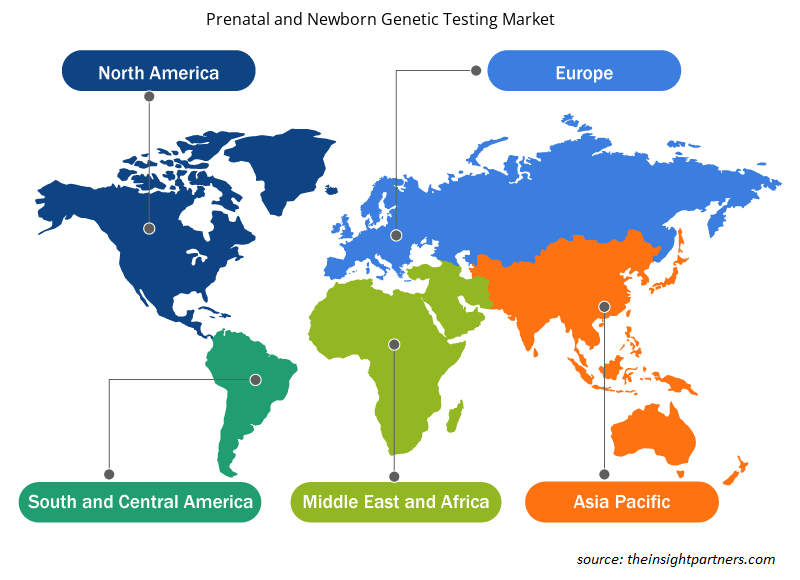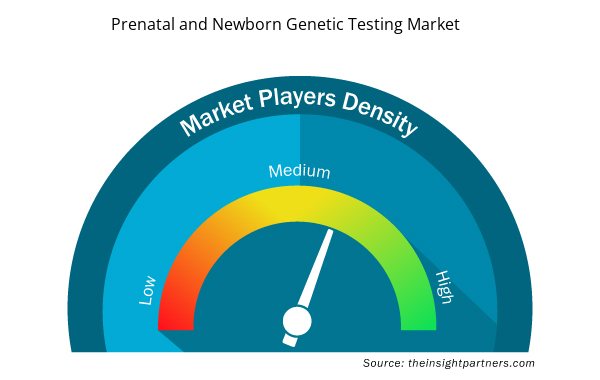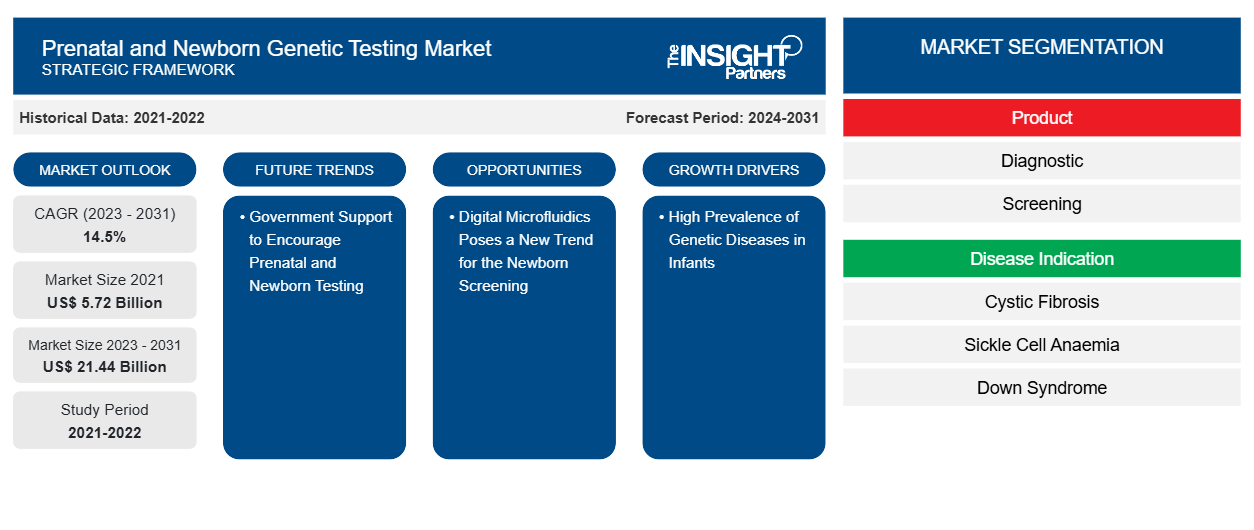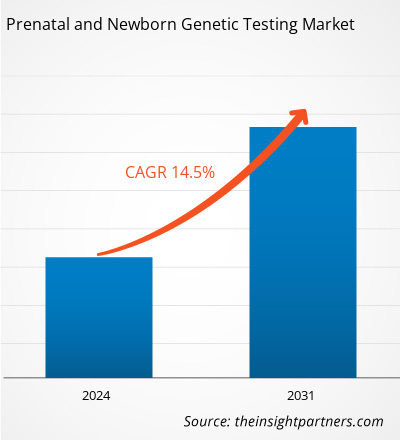2021 年产前和新生儿基因检测市场规模为 57.2 亿美元,预计到 2031 年将达到 214.4 亿美元。预计 2023-2031 年市场复合年增长率为 14.5%。用于新生儿筛查的数字微流控技术很可能仍是产前和新生儿基因检测市场的主要趋势。
产前及新生儿基因检测市场分析
提高技术能力、提高对产前和新生儿筛查基因检测的接受度和认知度、以及对个性化医疗保健的日益重视是推动市场增长的一些因素。基因检测解决方案在改善早期诊断、做出明智决策以及为孕妇和婴儿提供更好的医疗保健结果方面发挥着至关重要的作用,决定着市场的未来。在产前和新生儿筛查领域运营的诊断公司数量不断增加,以及公共和私人投资不断增加,预计将在预测期内促进市场扩张。
产前及新生儿基因检测市场概览
产前基因检测是在怀孕期间进行的,用于诊断疾病或检测妊娠 8 至 10 周前的特定基因异常。大多数产前基因检测使用母亲的血液样本进行各种筛查。产前和新生儿基因检测用于识别基因异常的需求不断增长,以及 Genomic Health Inc. 和国家人类基因组研究所等公共和私人公共组织的存在,正在支持市场的增长。美国临床化学协会 (AACC) 认为新生儿筛查是改善儿童健康的关键因素。作为一项管理婴儿遗传疾病的努力,AACC 支持公私合作维持、改善和扩大新生儿筛查计划的努力。此外,母亲年龄的增长导致妊娠并发症,这正在推动全球对产前基因检测的需求。
定制此报告以满足您的需求
您可以免费定制任何报告,包括本报告的部分内容、国家级分析、Excel 数据包,以及为初创企业和大学提供优惠和折扣
- 获取此报告的关键市场趋势。这个免费样品将包括数据分析,从市场趋势到估计和预测。
产前和新生儿基因检测市场驱动因素和机遇
婴儿遗传病高发推动市场增长
子宫内的胎儿受到各种遗传疾病的影响。这些遗传疾病的遗传方式有助于确定它们对怀孕造成的风险及其复发风险。在几种情况下,新生儿患遗传疾病的风险很高,例如父母的另一个孩子患有遗传疾病、有遗传疾病的家族史,或者父母一方有染色体异常。婴儿中遗传疾病的患病率很高,这些疾病也是全球婴儿死亡的原因。唐氏综合症是世界上最常见的智力障碍。它仍然是美国诊断出的最常见的染色体疾病,每 700 名婴儿中就有 1 名患有唐氏综合症。根据疾病控制和预防中心 (CDC) 的数据,美国每年出生的约 6,000 名婴儿患有唐氏综合症。世界卫生组织估计,全球每年有 240,000 名新生儿在出生后 28 天内死于这些疾病。另外,1个月至5岁之间有17万名儿童因先天性疾病死亡。因此,婴儿遗传病的流行增加了对产前和新生儿基因检测的需求,从而推动了市场的增长。
政府支持鼓励产前和新生儿检测以促进市场增长
随着基因组科学领域的发展,基因和基因组测试在各种临床和医疗机构中变得越来越普遍。世界各国政府和医疗监管机构都认识到基因测试的重要性及其带来的好处。为了确保新生儿的健康,世界各地的政府采取了各种举措,要求婴儿接受新生儿筛查。加州新生儿筛查 (NBS) 计划是一项公共卫生计划,旨在筛查所有新生儿是否患有几种严重但可治疗的遗传疾病。同样,在印度,生物技术部于 2019 年启动了 UMMID 计划(管理和治疗遗传疾病的独特方法)。该计划旨在促进该国婴儿的基因筛查。因此,政府加大支持力度,推动全球产前和新基因检测的使用,预计将促进未来市场的增长。
产前及新生儿基因检测市场报告细分分析
有助于产前和新生儿基因检测市场分析的关键部分是产品、疾病指征和最终用户。
- 根据产品,产前和新生儿基因检测市场分为诊断和筛查。筛查部分在 2023 年占据最大市场份额,预计在预测期内将实现最高复合年增长率。
- 根据疾病适应症,市场分为囊性纤维化、镰状细胞性贫血、唐氏综合症、苯丙酮尿症和其他疾病。唐氏综合症在 2023 年占据了最大的市场份额。此外,囊性纤维化领域预计在预测期内的复合年增长率最高。
- 根据最终用户,产前和新生儿基因检测市场分为医院和诊所、诊断中心和其他最终用户。医院和诊所部分在 2023 年占据最大的市场份额。此外,预计诊断中心部分在预测期内的复合年增长率最高。
产前和新生儿基因检测市场份额(按地区)分析
产前和新生儿基因检测市场报告的地理范围主要分为五个区域:北美、亚太、欧洲、中东和非洲、南美和中美。
北美主导着产前和新生儿基因检测市场。北美市场正在扩大,原因有很多,包括婴儿遗传病患病率的增加、政府的支持性举措以及各组织为促进产前和新生儿检测的使用而采取的举措,以及出生率的提高。根据疾病预防控制中心的数据,在美国,每年每 33 个新生儿中就有 1 个患有先天缺陷。此外,由于监管部门要求进行产前和新生儿检测,医疗保健领域对先进方法整合的日益重视,以及该地区推出用于产前和基因检测诊断的非侵入性检测,预计预测期内该地区的市场需求将大幅增长。预计亚太地区将在未来几年以最高的复合年增长率增长。
产前和新生儿基因检测市场区域洞察
Insight Partners 的分析师已详细解释了预测期内影响产前和新生儿基因检测市场的区域趋势和因素。本节还讨论了北美、欧洲、亚太地区、中东和非洲以及南美洲和中美洲的产前和新生儿基因检测市场细分和地理位置。

- 获取产前和新生儿基因检测市场的区域特定数据
产前及新生儿基因检测市场报告范围
| 报告属性 | 细节 |
|---|---|
| 2021 年市场规模 | 57.2亿美元 |
| 2031 年市场规模 | 214.4亿美元 |
| 全球复合年增长率(2023 - 2031) | 14.5% |
| 史料 | 2021-2022 |
| 预测期 | 2024-2031 |
| 涵盖的领域 | 按产品
|
| 覆盖地区和国家 | 北美
|
| 市场领导者和主要公司简介 |
|
产前和新生儿基因检测市场参与者密度:了解其对业务动态的影响
产前和新生儿基因检测市场正在快速增长,这得益于终端用户需求的不断增长,而这些需求又源于消费者偏好的不断变化、技术进步以及对产品优势的认识不断提高等因素。随着需求的增加,企业正在扩大其产品范围,进行创新以满足消费者的需求,并利用新兴趋势,从而进一步推动市场增长。
市场参与者密度是指在特定市场或行业内运营的企业或公司的分布情况。它表明相对于给定市场空间的规模或总市场价值,有多少竞争对手(市场参与者)存在于该市场空间中。
在产前和新生儿基因检测市场运营的主要公司有:
- 雅培
- Quest Diagnostics 公司
- Bio-Rad 实验室有限公司
- Illumina 公司
- F.霍夫曼罗氏有限公司
- Qigen
免责声明:上面列出的公司没有按照任何特定顺序排列。

- 了解产前和新生儿基因检测市场顶级关键参与者概况
产前和新生儿基因检测市场新闻和最新发展
产前和新生儿基因检测市场通过收集一级和二级研究后的定性和定量数据进行评估,其中包括重要的公司出版物、协会数据和数据库。以下是产前和新生儿基因检测市场的发展和策略列表:
- PerkinElmer Inc. 获得美国食品药品监督管理局 (FDA) 授权,可销售 EONIS SCID-SMA 检测试剂盒,供经认证的实验室进行体外诊断 (IVD),同时检测新生儿脊髓性肌萎缩症 (SMA) 和严重联合免疫缺陷症 (SCID)。这是 FDA 授权的首个美国新生儿 SMA 筛查检测,是该公司更广泛的 EONIS 平台的一部分。(来源:PerkinElmer Inc.,新闻稿,2022 年)
- LifeCell International 推出了“Genome-Scope”——一种针对新生儿的顶级基因诊断测试,可评估数千种儿童早期发病疾病。(来源:LifeCell International Private Limited,新闻稿,2020 年)
产前和新生儿基因检测市场报告覆盖范围和交付成果
“产前和新生儿基因检测市场规模和预测(2021-2031)”报告对以下领域进行了详细的市场分析:
- 范围内涵盖的所有主要细分市场的全球、区域和国家层面的市场规模和预测。
- 市场动态,如驱动因素、限制因素和关键机遇
- 未来主要趋势
- 详细的 PEST/波特五力分析和 SWOT 分析
- 全球和区域市场分析涵盖关键市场趋势、主要参与者、法规和最新市场发展
- 行业格局和竞争分析,涵盖市场集中度、热点图分析、知名参与者和最新发展
- 详细的公司简介
- 历史分析(2 年)、基准年、预测(7 年)及复合年增长率
- PEST 和 SWOT 分析
- 市场规模价值/数量 - 全球、区域、国家
- 行业和竞争格局
- Excel 数据集



Report Coverage
Revenue forecast, Company Analysis, Industry landscape, Growth factors, and Trends

Segment Covered
This text is related
to segments covered.

Regional Scope
North America, Europe, Asia Pacific, Middle East & Africa, South & Central America

Country Scope
This text is related
to country scope.
Trends and growth analysis reports related to Life Sciences : READ MORE..
The Insight Partners performs research in 4 major stages: Data Collection & Secondary Research, Primary Research, Data Analysis and Data Triangulation & Final Review.
- Data Collection and Secondary Research:
As a market research and consulting firm operating from a decade, we have published and advised several client across the globe. First step for any study will start with an assessment of currently available data and insights from existing reports. Further, historical and current market information is collected from Investor Presentations, Annual Reports, SEC Filings, etc., and other information related to company’s performance and market positioning are gathered from Paid Databases (Factiva, Hoovers, and Reuters) and various other publications available in public domain.
Several associations trade associates, technical forums, institutes, societies and organization are accessed to gain technical as well as market related insights through their publications such as research papers, blogs and press releases related to the studies are referred to get cues about the market. Further, white papers, journals, magazines, and other news articles published in last 3 years are scrutinized and analyzed to understand the current market trends.
- Primary Research:
The primarily interview analysis comprise of data obtained from industry participants interview and answers to survey questions gathered by in-house primary team.
For primary research, interviews are conducted with industry experts/CEOs/Marketing Managers/VPs/Subject Matter Experts from both demand and supply side to get a 360-degree view of the market. The primary team conducts several interviews based on the complexity of the markets to understand the various market trends and dynamics which makes research more credible and precise.
A typical research interview fulfils the following functions:
- Provides first-hand information on the market size, market trends, growth trends, competitive landscape, and outlook
- Validates and strengthens in-house secondary research findings
- Develops the analysis team’s expertise and market understanding
Primary research involves email interactions and telephone interviews for each market, category, segment, and sub-segment across geographies. The participants who typically take part in such a process include, but are not limited to:
- Industry participants: VPs, business development managers, market intelligence managers and national sales managers
- Outside experts: Valuation experts, research analysts and key opinion leaders specializing in the electronics and semiconductor industry.
Below is the breakup of our primary respondents by company, designation, and region:

Once we receive the confirmation from primary research sources or primary respondents, we finalize the base year market estimation and forecast the data as per the macroeconomic and microeconomic factors assessed during data collection.
- Data Analysis:
Once data is validated through both secondary as well as primary respondents, we finalize the market estimations by hypothesis formulation and factor analysis at regional and country level.
- Macro-Economic Factor Analysis:
We analyse macroeconomic indicators such the gross domestic product (GDP), increase in the demand for goods and services across industries, technological advancement, regional economic growth, governmental policies, the influence of COVID-19, PEST analysis, and other aspects. This analysis aids in setting benchmarks for various nations/regions and approximating market splits. Additionally, the general trend of the aforementioned components aid in determining the market's development possibilities.
- Country Level Data:
Various factors that are especially aligned to the country are taken into account to determine the market size for a certain area and country, including the presence of vendors, such as headquarters and offices, the country's GDP, demand patterns, and industry growth. To comprehend the market dynamics for the nation, a number of growth variables, inhibitors, application areas, and current market trends are researched. The aforementioned elements aid in determining the country's overall market's growth potential.
- Company Profile:
The “Table of Contents” is formulated by listing and analyzing more than 25 - 30 companies operating in the market ecosystem across geographies. However, we profile only 10 companies as a standard practice in our syndicate reports. These 10 companies comprise leading, emerging, and regional players. Nonetheless, our analysis is not restricted to the 10 listed companies, we also analyze other companies present in the market to develop a holistic view and understand the prevailing trends. The “Company Profiles” section in the report covers key facts, business description, products & services, financial information, SWOT analysis, and key developments. The financial information presented is extracted from the annual reports and official documents of the publicly listed companies. Upon collecting the information for the sections of respective companies, we verify them via various primary sources and then compile the data in respective company profiles. The company level information helps us in deriving the base number as well as in forecasting the market size.
- Developing Base Number:
Aggregation of sales statistics (2020-2022) and macro-economic factor, and other secondary and primary research insights are utilized to arrive at base number and related market shares for 2022. The data gaps are identified in this step and relevant market data is analyzed, collected from paid primary interviews or databases. On finalizing the base year market size, forecasts are developed on the basis of macro-economic, industry and market growth factors and company level analysis.
- Data Triangulation and Final Review:
The market findings and base year market size calculations are validated from supply as well as demand side. Demand side validations are based on macro-economic factor analysis and benchmarks for respective regions and countries. In case of supply side validations, revenues of major companies are estimated (in case not available) based on industry benchmark, approximate number of employees, product portfolio, and primary interviews revenues are gathered. Further revenue from target product/service segment is assessed to avoid overshooting of market statistics. In case of heavy deviations between supply and demand side values, all thes steps are repeated to achieve synchronization.
We follow an iterative model, wherein we share our research findings with Subject Matter Experts (SME’s) and Key Opinion Leaders (KOLs) until consensus view of the market is not formulated – this model negates any drastic deviation in the opinions of experts. Only validated and universally acceptable research findings are quoted in our reports.
We have important check points that we use to validate our research findings – which we call – data triangulation, where we validate the information, we generate from secondary sources with primary interviews and then we re-validate with our internal data bases and Subject matter experts. This comprehensive model enables us to deliver high quality, reliable data in shortest possible time.


 获取此报告的免费样本
获取此报告的免费样本